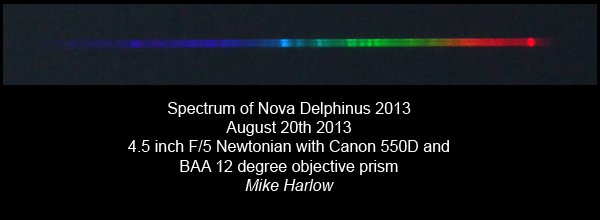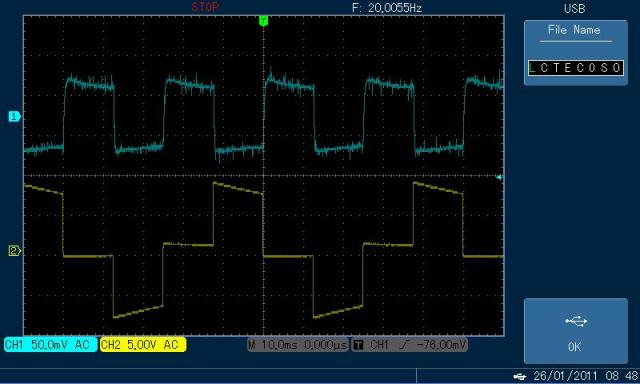› Forums › Variable Stars › Bright Nova in Delphinus
- This topic has 19 replies, 1 voice, and was last updated 10 years, 4 months ago by
Dominic Ford (site admin).
-
AuthorPosts
-
15 August 2013 at 2:44 pm #573277
Dominic Ford (site admin)
ParticipantPosted by Gary Poyner at 14:44 on 2013 Aug 15
Patrick Schmeer posted this notice to BAAVSS-Alert group last night…>PNV J20233073+2046041>Koichi Itagaki (Yamagata, Japan) reports the discovery of an apparent nova >of magnitude 6.8in Delphinus:>Recent observations reported to the AAVSO database show this object has risen to magnitude 5.5 by mid-day Aug 15.A nice image and details of the discovery can be found on the BAAVSS web pages http://www.britastro.org/vss/Gary
Attachments:
15 August 2013 at 7:21 pm #576295Dominic Ford (site admin)
ParticipantPosted by Paul A Brierley at 19:21 on 2013 Aug 15
If skies are clear over the week-end. I hope to secure an image of this. I’ll be using a 135mm F3.4 Telephoto lens and EOS 1000D on a portable Alt/AZ mount.Fingers crossed.
15 August 2013 at 11:18 pm #576296Dominic Ford (site admin)
ParticipantPosted by Nick James at 23:18 on 2013 Aug 15
I’ve put a couple of images of it taken from Essex (wide and narrow field) here:http://www.nickdjames.com/Media/Astronomy/N_Del_2013/Nick.
16 August 2013 at 4:34 pm #576297Dominic Ford (site admin)
ParticipantPosted by Neil Morrison at 16:34 on 2013 Aug 16
I am fairly confident that I have obtained an image of the Nova last evening 15th august at 21.03 gmt. Equipment Konica Minolta 5D Samyang 85mm f1.4 10sec at Iso 400 . Compairing the image with page 163 of Uranometria 2000 there is a star of at least Magnitude 6 at the correct position. The Camera was mounted on a driven Vixen Super Polaris mount atop a Orion Field tripod. The Sky conditions were not the dest with some haze and Cirrus , also the Moon !!
17 August 2013 at 1:55 am #576298Dominic Ford (site admin)
ParticipantPosted by David Arditti at 01:55 on 2013 Aug 17
Here’s another image, taken August 16 in moonlight with a Canon EOS 400D and old SLR 28mm lens.
 17 August 2013 at 11:01 am #576299
17 August 2013 at 11:01 am #576299Dominic Ford (site admin)
ParticipantPosted by Gary Poyner at 11:01 on 2013 Aug 17
Is anyone seeing it naked eye? I saw it last night from North Birmingham. First NE Nova since 1999 in the Northern sky. Fantastic!!! It looks to be fading now though, so if you want to see it ‘for real’, you might have to be quick!Gary
17 August 2013 at 1:11 pm #576300Dominic Ford (site admin)
ParticipantPosted by David Strange at 13:11 on 2013 Aug 17
Yes saw it naked eye from Branscombe valley last night when coming back home from the NLO.Slightly dimmer than gamma SGE.
17 August 2013 at 10:48 pm #576301Dominic Ford (site admin)
ParticipantPosted by Edward Sawyer at 22:48 on 2013 Aug 17
Yes,I saw it naked eye 2013 Aug 17d 02:53UT from Chicoutimi (71.049 deg west; 48.401deg N. I perceived it as the same brightness as 29 Vul, so 4.8 and considerably brighter than Eta Sge.Edward Sawyer
19 August 2013 at 6:52 am #576302Dominic Ford (site admin)
ParticipantPosted by Paul A Brierley at 06:52 on 2013 Aug 19
I saw it through 10x50B in very bright Moon light, between 2045 and 2050hrs UT. It was a quick observation. I was fighting clouds.I could not say what magnitude it was.
19 August 2013 at 6:37 pm #576303Dominic Ford (site admin)
ParticipantPosted by Edward Sawyer at 18:37 on 2013 Aug 19
Nova in DelphiniusNaked eye observation 2013 Aug 18d 04:02UT from Chicoutimi Quebec. Difficult in moonlit sky, but seen direct vision. I estimated its brightness as between 29 Vul (4.81) and Zeta Del (4.66). Confirmed using 7 x 42 binoculars.Edward Sawyer
19 August 2013 at 10:36 pm #576304Dominic Ford (site admin)
ParticipantPosted by Darren Murray at 22:36 on 2013 Aug 19
I did a visual observation of this on Fri 16th,it was very bright and had a lovely golden/yellow hue in my 8" SCT unfortunately I still don’t feel confident enough to make a magnitude estimate so I just observed it for a good 2 hours.it did seem to get a little brighter by then end of the night but that could of been down to the street lights switching off ..
20 August 2013 at 8:42 am #576305Dominic Ford (site admin)
ParticipantPosted by Gary Poyner at 08:42 on 2013 Aug 20
It’s great to see observers seeing the Nova with both NE and bins, but it would be nice to see a few estimates too! It’s not hard – and easier to do than explain…using the chart on the VSS web page, chose two stars about 0.5 mag or less apart and mentally place the brightness of the Nova in between. You should then be able to make a good estimate of it’s brightness. Go on, have a go!Gary
20 August 2013 at 10:10 am #576306Dominic Ford (site admin)
ParticipantPosted by Darren Murray at 10:10 on 2013 Aug 20
ok Gary I will have a go tonight its looking like it could be clear 🙂 I will do my best to get a good estimate 🙂
20 August 2013 at 12:59 pm #576307Dominic Ford (site admin)
ParticipantPosted by Gary Poyner at 12:59 on 2013 Aug 20
Good luck Darren – and to anyone else who decides to have a go!Gary
22 August 2013 at 10:47 pm #576309Dominic Ford (site admin)
ParticipantPosted by Mike Harlow at 22:47 on 2013 Aug 22
I had my first opportunity to image the nova on Tuesday night and got some reasonable shots despite the full Moon. But my main reason for observing was to try to get a spectrum of the nova using the objective prism I have on loan from the BAA instrument collection. I haven’t had a chance to calibrate the spectrum yet but it does show some nice emission lines as well as some very faint absorption lines. It will be interesting to see how the spectrum evolves as the nova fades.Image details:4.5 inch F/5 Newtonian with 12 degree flint objective prism mounted over the front end. Unmodified Canon 550 DSLR hence the sharp cut-off beyond the H alpha emission line. ISO800 and 20 second exposure with slow drive rate to spread out the spectrum.See: http://www.oasi.org.uk/Obsvns/20130127_spectra/20130127_spectra.shtml for more details.
 24 August 2013 at 4:25 pm #576310
24 August 2013 at 4:25 pm #576310Dominic Ford (site admin)
ParticipantPosted by Robin Leadbeater at 16:25 on 2013 Aug 24
Nice spectrum Mike, you don’t see many objective prism spectra these days. The simple Star Analyser grating spectra are also showing the emission lines in this object well.Amateur Paolo Beradi has produced a rather nice animation showing the evolution over the first 6 days at a resolution of ~2.5A using a LHIRES Littrow spectrograph herehttp://quasar.teoth.it/html/spectra/novadel_15_21.gifI am currently concentrating on the blue end of the spectrum where lines from the CN molecule may appear soon signalling the generation of dust.The object has raised a lot of interest among amateur spectroscopists. This has developed into an impromptu worldwide amateur spectroscopy campaign coordinated by the amateur ARAS group with over 250 spectra to date. Steve Shore at the University of Pisa is acting as unofficial PI and mentor see ATEL here http://www.astronomerstelegram.org/?read=5312and the thread on the ARAs forum which includes some notes by Steve Shore on what is happening at each stage as this object evolveshttp://www.spectro-aras.com/forum/viewtopic.php?f=5&t=682CheersRobinwww.threehillsobservatory.co.uk
24 August 2013 at 7:12 pm #576312Dominic Ford (site admin)
ParticipantPosted by Robin Leadbeater at 19:12 on 2013 Aug 24
Hi again Mike,I used Visual Spec software to digitise your image and did a 2nd order wavelength calibration on your spectrum (using the bright H alpha, beta, gamma emission lines) The resulting calibration is only a very rough approximation to the true dispersion equation of the prism but comparing with a spectrum taken by Olivier Thizy on the same night,taken from the ARAS databasehttp://www.astrosurf.com/aras/Aras_DataBase/Novae/Nova-Del-2013.htmthe same features are clear in both spectra. (The overall shape is different as Oliver’s spectrum has been corrected for instrument response and atmospheric extinction) (EDIT: There should be an image attached but it is not there for some reason which escapes me)Robin
 24 August 2013 at 8:41 pm #576313
24 August 2013 at 8:41 pm #576313Dominic Ford (site admin)
ParticipantPosted by Mike Harlow at 20:41 on 2013 Aug 24
Hi Robin,Many thanks for all the information and links. I’m relatively new to spectroscopy so any help/encouragement is most welcome!An objective prism appealed to me as I could simply put it in front of my existing imaging equipment without modification and it gives a single, bright spectrum. Luckily Bob Marriott dug one out of the BAA instrument collection for me to play with.Regarding the spectrum…I’m curious to know what the lines between about 520 and 540nm are due to? And you mention CN emission…what wavelengths will they appear at?By the way, I initially had trouble getting my image to appear until Roger Pickard put it on the VSS web page and I could link to there.When I get some more results I’ll let you know.Thanks again,Mike.
24 August 2013 at 9:41 pm #576314Dominic Ford (site admin)
ParticipantPosted by Robin Leadbeater at 21:41 on 2013 Aug 24
Hi Mike,Mike Harlow wrote:
Regarding the spectrum…I’m curious to know what the lines between about 520 and 540nm are due to?They are Fe II lines which characterises the type of nova You either get Fe II or He/N lines appearing depending on the type. See this article by Francois Teyssier for example who is currently coordinating the amateur end of the spectroscopy campaignhttp://www.rspec-astro.com/download/Nova-A9RCDC6.fr.en.pdf
And you mention CN emission…what wavelengths will they appear at?According to Steve Shore CN absorption lines may appear briefly at 4216 and 3886A sometime in the next week. Here is a spectrum I took on 20th. http://www.spectro-aras.com/forum/download/file.php?id=1079The two broad lines in the centre are the CaHK lines showing the classic P Cygni type shape with emission and blue shifted absorption components as the hot gas from the explosion travels outwards (The narrow absorption lines are from interstellar Ca) no sign of CN there yet though.Robin
29 November 2013 at 4:24 pm #576378Dominic Ford (site admin)
ParticipantPosted by Gary Poyner at 16:24 on 2013 Nov 29
Whilst everyone is going Comet crazy at the moment (and rightly so I guess), lets not forget this Nova in Delphinus. We are just past the first 100 days since it first appeared in our skies as a naked eye star, and it’s still visible around magnitude 11.0 in the evening sky. It’s usually around this brightness level that interest in Novae wanes amongst observers, so I’m appealing to all those observers with small telescopes, DSLR’s/CCD’s to continue monitoring the Nova for as long as possible in the evening sky – and importantly report your data to the VSS AND to Guy Hurst.The Nova is now in the nebular phase, and has been steady’ish around magnitude 11 since the middle of October. However some Novae develop a dusty environment which can manifest itself at this stage of the decline, so it’s quite possible that Nova Del (or V339 Del as it’s now known) just might take a dramatic fade. And remember…you don’t need to get up at Dawn to see it :-)Gary
-
AuthorPosts
- You must be logged in to reply to this topic.

